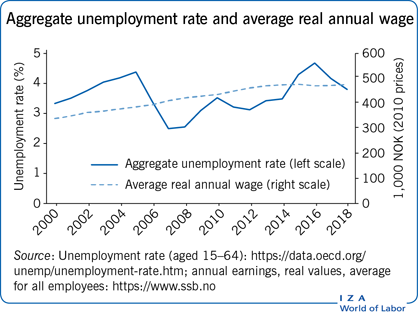Elevator pitch
Norway has a rather high labor force participation rate and a very low unemployment rate. Part of the reason for this fortunate situation is the so-called “tripartism”: a broad agreement among unions, employers, and government to maintain a high level of coordination in wage bargaining. This has led to downward real wage flexibility, which has lessened the effects of negative shocks to the economy. Reduced net immigration, especially from neighboring countries, also mitigated the negative effects of the oil price drop in 2014. A potential drawback of tripartism is the difficulty of reducing employee absences and disability.

Key findings
Pros
Both men and women enjoy high employment.
Real wage flexibility has helped combat unemployment, especially after the drop in oil prices in 2014.
Unemployment is quite low, also among young individuals.
There is a downward-sloping trend of part-time work among women.
Wages are compressed, and wage inequality is rather small and relatively stable.
Cons
Worker absences due to sickness as well as disability rates are high, putting pressure on the welfare state.
The overall employment rate is trending downwards possibly related to an aging population.
The labor market is highly gender segregated with respect to sector and occupation.
The school drop-out rate has started to increase among young men.